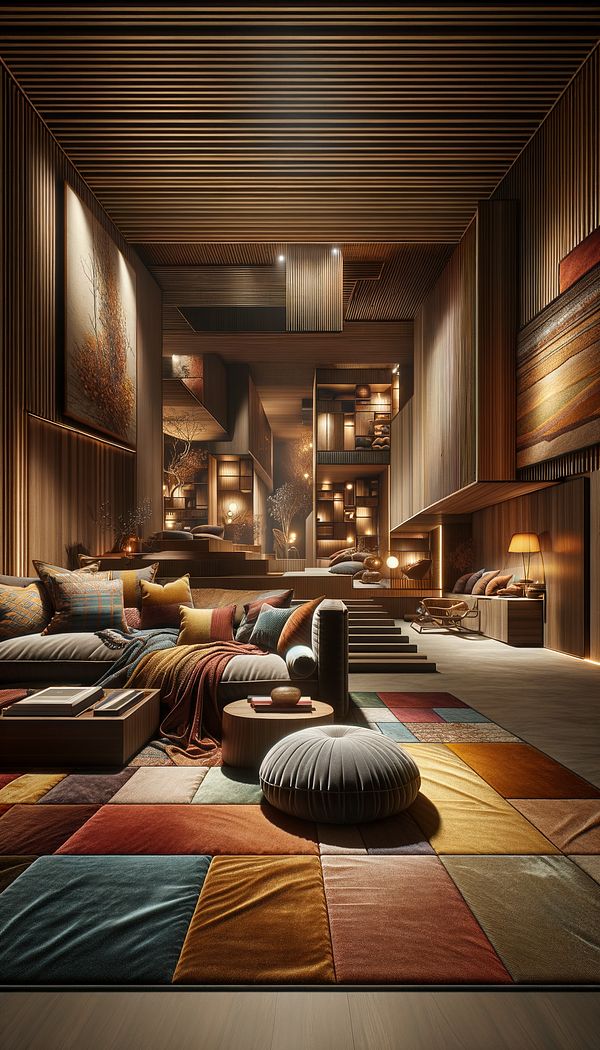What is Layered?
Layered refers to the technique of adding multiple elements to create depth and interest in an interior design.
Description
Layered in the context of interior design is a sophisticated approach that involves the deliberate addition of multiple design elements to create a space that feels rich, complex, and inviting. The technique aims to introduce depth, texture, and dimension, making rooms appear more interesting and lived-in. The concept of layering can apply to various aspects of interior design including color and patterns, materials and textiles, lighting, furniture types, and decorative objects.
Effective layering harmonizes contrasting elements without making the space feel cluttered. It's about finding the right balance between aesthetics and functionality, where each layer serves a purpose while contributing to the overall look and feel. From a tactile perspective, layering can introduce a variety of textures that appeal to the senses, while visually, it can help to define different zones in an open-plan space, enhance the sense of warmth, or convey a particular style or theme.
Mastering the art of layering requires a keen eye for detail, the ability to envision the end result, and the skill to mix and match different elements cohesively. It often involves experimentation and the willingness to adjust compositions until the perfect balance is achieved. When done successfully, layering elevates the design from merely functional to exceptionally engaging and personal.
Usage
In practice, layered design might manifest as a living room that features a rich mix of textiles like plush velvet sofas, woven rugs, and silky cushions, alongside a variety of lighting sources such as floor lamps, table lamps, and wall sconces. Or, it might be seen in a bedroom where the bedding, throw blankets, pillows, and window treatments all contribute to a deeply inviting and cohesive space. The key is to intentionally combine elements to achieve a depth that would be impossible with a single-layer approach.
FAQs
-
How do you achieve a layered interior design?
Achieving a layered interior design involves thoughtfully combining various elements such as furniture, textiles, lighting, and decor to create depth and interest. It's about balancing different textures, colors, and patterns, and ensuring there's a cohesive theme that ties all elements together. Experimentation and adjustment are essential in finding the perfect mix.
-
Can layering make a small space feel crowded?
If not done carefully, layering can indeed make a small space feel crowded or cluttered. However, using the technique wisely by focusing on proportion, scale, and the right mix of elements can actually enhance the perceived size of a space, making it feel cozy and inviting rather than confined.
-
Is layering only for certain interior design styles?
No, layering is a versatile technique that can be applied across various interior design styles. Whether the space is modern, traditional, eclectic, or minimalist, layering can enhance the aesthetic appeal by adding depth and interest. The key is to adapt the concept of layering to fit the overall style and vision of the space.
Practical Application
When starting to layer your space, begin with larger foundational pieces such as furniture, followed by middle-sized accessories like rugs and curtains, and finish with smaller decorative items and personal touches. Don't forget to consider lighting at each stage, as it can dramatically affect how colors and textures appear. Lastly, allow for breathing room between elements to avoid a cluttered look and ensure that each piece has its moment to shine.
-
Design Styles478 articles
-
Lighting111 articles
-
Decorative Objects240 articles
-
Decorating Principles & Elements330 articles
-
Materials & Textiles360 articles
-
EyeletA small hole with reinforced stitching or metal surrounding it, used for decoration or functionality in fabrics.
-
Chair RailChair rail is a type of molding fixed horizontally to the wall around the perimeter of a room.
-
Tuxedo ArmsTuxedo Arms are a distinctive style of armrest found on some sofas and chairs, characterized by their high, straight profile that aligns with the back of the furniture.
-
OmbreOmbre is a design technique featuring a gradual blending of one color hue to another, usually moving tints and shades from light to dark.
-
Spanish RenaissanceSpanish Renaissance refers to a period and style in interior design characterized by ornate decorations, rich colors, and intricate details.
